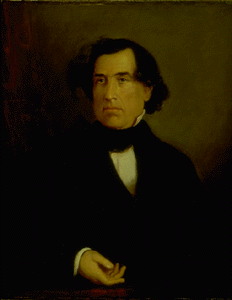Indiana Governor Portrait Artist: James Forbes (c. 1800 - ?) - Whitcomb
James Forbes
Artist, Indiana Governors' Portrait Collection

James Whitcomb (1795-1852)
Governor of IndianaDecember 6, 1843-December 26, 1848
oil on canvas, 36 1/8 x 29 1/8 (91.8 x 74.0)
Signed bottom center: Jas. Forbes Pinx
THE OFFICIAL portrait of James Whitcomb is the work of the Scottish artist, James Forbes. This and Forbes's previous commissions from the state were carried out in Evansville early in the fall of 1869. Like his portraits of Jennings and Boon, the portrait of Whitcomb was painted from another picture.
Whitcomb had died in 1852 and Governor Baker had some difficulty securing good pictures for Forbes to copy. The first that he found was an oil portrait made from a daguerreotype about 1849 when Whitcomb was in the United States Senate. The owner, Mrs. Claude Matthews of Clinton, Indiana, daughter of James Whitcomb, prized it highly and regarded it as an excellent likeness. The artist, on the contrary, did not find it a good model for his work, judging by his letter to Governor Baker: "After I had cleaned and varnished the portrait of Gov. Whitcomb, it looked so much improved, that I commenced a copy of it. . . I hope however you will find a daguerreotype or photograph of some sort for me to copy from - for tho this may be a very cognizable likeness It wants individuality-or mental character.- Has a vapid expression that makes one feel they are looking on a poorly painted picture, instead of on the man himself."(1)
A damaged and faded daguerreotype was owned by a descendant in Chillicothe, Ohio, but due to its condition steps were not immediately taken to secure it, a photograph of it being borrowed instead. The pentimento in the portrait made visible by the fading of upper layers of pigment indicates a probable change in the position of the figure's head. Forbes must have felt the necessity to begin the portrait anew, once the photograph was in his hands. Judging from correspondence, the finishing touches were not added until the daguerreotype was in the artist's studio. (2)
When the portrait was finally finished, Forbes placed it on view in Evansville for the inspection of Whitcomb's old friends. "Drs. Bray, Casselberry, and De Bruler, Major Robinson and several others called to see Gov. Whitcomb's portrait," wrote Forbes to Governor Baker. "I am glad to say they each thought the likeness good tho some at first could barely recollect the features after so many years."(3)
Like the other portraits by James Forbes, the study of Whitcomb, although largely from a photograph, has a good deal of pictorial charm and breadth of execution. The governor's dark suit and mass of black hair are placed against a warm gray background with a red tablecloth adding a pleasing note of color to the arrangement. The turn of the governor's head and gesture of his hand give the pose considerable animation. However, Forbes has failed to convey the intellectual force and fine character which are synonymous with Whitcomb's name. The rather listless eyes and weak mouth are probably due to the poor prototypes Forbes had to follow, and judging by remarks he made in his letters to Conrad Baker, he himself was not entirely satisfied with the result.
(1) Forbes to Governor Baker, September 27, 1869. Governor Baker's correspondence.
(2) Forbes to Governor Baker, September 27 and October 20, 1869; Claude Matthews to Governor Baker, September 27 and October 3, 1869; Forbes to John M. Commons, October 11, 18, 1869; R. R. Seymour to Governor Baker, October 20, 1869, Governor Baker's correspondence. The daguerreotype was the property of R. R. Seymour of Chillicothe, Ohio, a brother-in-law of Governor Whitcomb.
(3) Forbes to Governor Baker, October 20, 1869. Ibid.
Source: Peat, Wilbur D. Portraits and Painters of the Governors of Indiana 1800-1978. Revised, edited and with new entries by Diane Gail Lazarus, Indianapolis Museum of Art. Biographies of the governors by Lana Ruegamer, Indiana Historical Society. Indianapolis: Indiana Historical Society and Indianapolis Museum of Art, 1978.
